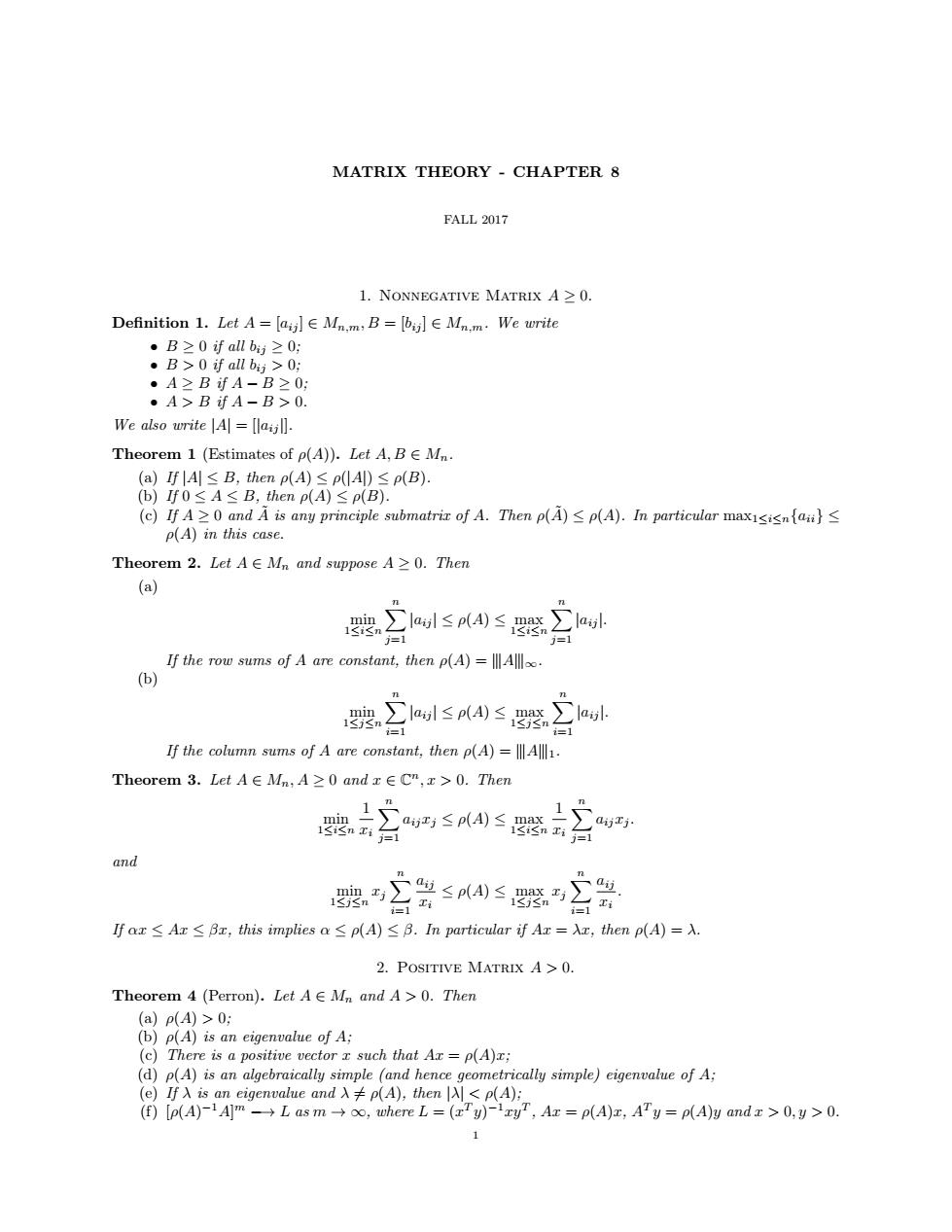正在加载图片...

MATRIX THEORY CHAPTER 8 FALL 2017 1.NONNEGATIVE MATRIX A Z 0. Definition 1.Let A=Mm B=Mm:We write ·B≥0 if all bi≥0 A>BUA-B-0. We also write Al -[. Theorem 1(Estimates of p(A)).Let A,BEM. 8是 ()(B) (d)fA≥0 and A is any principle submatrir of A.Then p(A≤p(A).n particular max≤isnf{ar}≤ p(A)in this case. Theorem 2.Let AEM and suppose A.Then (a) 盟∑lal≤≤器∑al 1 =1 If the row sums of A are constant,then p(A)=Allloc. 6 哭lal≤≤,器∑al If the column sums of A are constant,then p(A)=Al. Theorem3.LetA∈M,A≥0amdx∈C",x>0.Them 1 院名器 and 票上兴≤≤器上岩 far≤Ar≤Bz,this implies o≤p(A)≤B.In particular if Ax=缸,then p(A)=入. 2.POSITIVE MATRIX A>0. Theorem 4 (Perron).Let AE Mn and A>0.Then cally simple)eigenvalue of A; 骨AA四Zsm,heL,A=pA5Ay=A)y amd红>0,y>0. MATRIX THEORY - CHAPTER 8 FALL 2017 1. Nonnegative Matrix A ≥ 0. Definition 1. Let A = [aij ] ∈ Mn,m, B = [bij ] ∈ Mn,m. We write • B ≥ 0 if all bij ≥ 0; • B > 0 if all bij > 0; • A ≥ B if A − B ≥ 0; • A > B if A − B > 0. We also write |A| = [|aij |]. Theorem 1 (Estimates of ρ(A)). Let A, B ∈ Mn. (a) If |A| ≤ B, then ρ(A) ≤ ρ(|A|) ≤ ρ(B). (b) If 0 ≤ A ≤ B, then ρ(A) ≤ ρ(B). (c) If A ≥ 0 and A˜ is any principle submatrix of A. Then ρ(A˜) ≤ ρ(A). In particular max1≤i≤n{aii} ≤ ρ(A) in this case. Theorem 2. Let A ∈ Mn and suppose A ≥ 0. Then (a) min 1≤i≤n Xn j=1 |aij | ≤ ρ(A) ≤ max 1≤i≤n Xn j=1 |aij |. If the row sums of A are constant, then ρ(A) = 9A9∞. (b) min 1≤j≤n Xn i=1 |aij | ≤ ρ(A) ≤ max 1≤j≤n Xn i=1 |aij |. If the column sums of A are constant, then ρ(A) = 9A91. Theorem 3. Let A ∈ Mn, A ≥ 0 and x ∈ C n, x > 0. Then min 1≤i≤n 1 xi Xn j=1 aijxj ≤ ρ(A) ≤ max 1≤i≤n 1 xi Xn j=1 aijxj . and min 1≤j≤n xj Xn i=1 aij xi ≤ ρ(A) ≤ max 1≤j≤n xj Xn i=1 aij xi . If αx ≤ Ax ≤ βx, this implies α ≤ ρ(A) ≤ β. In particular if Ax = λx, then ρ(A) = λ. 2. Positive Matrix A > 0. Theorem 4 (Perron). Let A ∈ Mn and A > 0. Then (a) ρ(A) > 0; (b) ρ(A) is an eigenvalue of A; (c) There is a positive vector x such that Ax = ρ(A)x; (d) ρ(A) is an algebraically simple (and hence geometrically simple) eigenvalue of A; (e) If λ is an eigenvalue and λ 6= ρ(A), then |λ| < ρ(A); (f) [ρ(A) −1A] m −→ L as m → ∞, where L = (x T y) −1xyT , Ax = ρ(A)x, AT y = ρ(A)y and x > 0, y > 0. 1